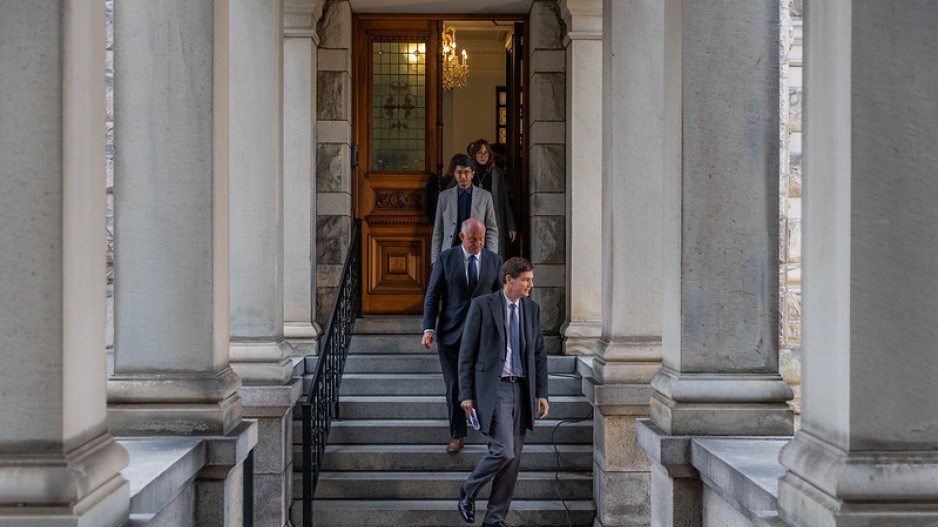Payroll for staff and contractors in Premier David Eby’s office was $768,000 in April, just $42,000 less than a year earlier when John Horgan was B.C.’s NDP premier.
According to documents released under freedom of information law, Horgan’s 100-person staff cost taxpayers $810,000 in April 2022.
Eby’s office counts 97 employees, who were paid $747,963.97 during the month, plus former Victoria mayor Lisa Helps as a housing adviser for $13,333.33 and Convergence Communications Inc. for $6,400. Convergence is co-owned by Mike Magee, who was chief of staff to ex-Vancouver mayor Gregor Robertson.
The list released by the Ministry of Finance does not include $275,000-a-year Indigenous reconciliation adviser Doug White or health adviser Penny Ballem at $170,000 a year. A fourth adviser, Thompson Rivers University law professor Craig Jones, is retained through the Legal Services Branch and Eby has refused to disclose payment terms.
Eby has five deputy and associate deputy ministers, a chief of staff and two deputy chiefs of staff. Horgan had eight deputy and associate deputy ministers, a chief of staff and two deputy chiefs of staff.
The top paid official under Eby is deputy minister and head of the public service Shannon Salter, who grossed $19,375.750 during April’s two pay periods, followed by: Deputy minister Douglas Caul ($16,305.07); chief of staff Matt Smith ($15,705.06); intergovernmental relations deputy minister Silas Brownsey ($14,237.10); and Megan Marshall, the director of strategic outreach and stakeholder relations ($12,621.10).
In April 2022, John Allan was Horgan’s special adviser for the natural resources sector and the month’s highest-paid member of the Office of the Premier at $91,934.29. Public accounts show Allan was also paid $339,781 during the fiscal year that ended March 31, 2022.
Next in the Horgan April 2022 pay parade were: Deputy minister and head of the public service Lori Wanamaker ($25,447.98); deputy minister of policy and coordination Mark Sieben ($20,668.26); deputy minister of strategic initiatives Jill Kot ($19,318.26); and chief of staff Geoff Meggs ($16,180.90).
When Eby took over from Horgan last November, Wanamaker got a pink slip and a $591,089 golden parachute, along with Meggs ($339,784), deputy chief of staff Amber Hockin ($189,291) and executive coordinator Jarrett Hagglund ($75,366).
The Office of the Premier includes the intergovernmental relations secretariat, cabinet operations, executive and support services and the planning and priorities secretariat. The latter was created after the 2020 snap election, tasked to work with ministries on cabinet social, economic and environmental initiatives.
In August 2020, the month before Horgan called the election, Horgan had 86 people on the payroll.
Horgan’s office got a $3.34 million-a-year budget bump in 2021 to $14.68 million. In February’s budget, it grew to $16.045 million under Eby. The biggest line item was executive and support services ($8.495 million, up from $7.5 million).
In April, Eby’s office included four protocol managers, three protocol assistants, a protocol and events assistant and a protocol chief, plus four people in communications, six in the correspondence department, six administrative assistants, five executive directors, three executive assistants and a senior executive assistant, and three executive coordinators.
During budget estimates debates on May 11, BC United leader Kevin Falcon said that the office’s budget had grown 78 per cent since 2012 when he left the BC Liberal government under then-premier Christy Clark.
“Yet we’re getting the worst results we’ve ever seen in housing. We’re getting the worst results we’ve ever seen in crime and social disorder and chaos as a result of [Eby’s] soft-on-crime policies and his catch-and-release system,” Falcon said. “We’re getting the worst possible results we’ve ever seen in terms of mental health and addictions. And we’re getting the worst results we’ve ever seen in the health care sector. Yet the budget has gone up 78 per cent.”
Eby said his budget is less than former premier Gordon Campbell’s in 2009.
Public accounts show that Campbell budgeted $14.1 million, but spent $13.524 million that year. Eby, citing the Bank of Canada inflation calculator, said Campbell’s budget then is worth $19.4 million now.
"The premier’s office budget also compares favourably to other major provinces. Ontario’s premier’s office budget is $57.5 million, Quebec’s is $50.3 million, Alberta’s is $34.6 million and B.C.’s is $16.045 million,” Eby said. “We’re actually closer to Nova Scotia’s budget than Alberta’s in terms of overall cost.”
For 2016-17, Clark’s last fiscal year in office, the Office of the Premier’s budget was $9.579 million, which would be $11.67 million after inflation.
In February, the NDP government budgeted $80.2 billion in overall spending, $77.69 billion revenue and a $4.216 billion deficit.



